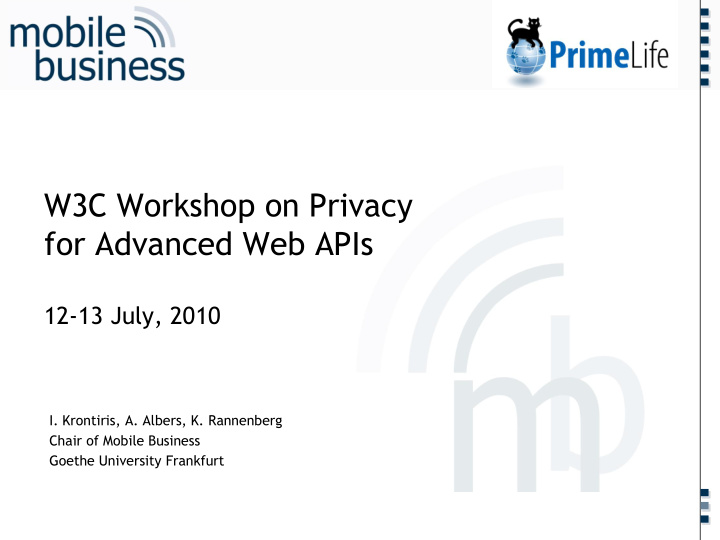



…… W3C Workshop on Privacy for Advanced Web APIs 12-13 July, 2010 I. Krontiris, A. Albers, K. Rannenberg Chair of Mobile Business Goethe University Frankfurt ...
…… location privacy ... 2
…… Location Privacy “… the ability to prevent other parties from learning one’s current or past location.“ (Beresford and Stajano, 2003) „It‘s not about where you are... It‘s where you have been!“ (Gary Gale, Head of UK Engineering for Yahoo! Geo Technologies) ... 3
…… Why share your location? Websites using the Geolocation API ... 4
…… Unlinkability Unlinkability of two or more items of interest (IOIs, e.g., subjects, messages, actions, ...) from an attacker’s perspective means that within the system (comprising these and possibly other items), the attacker cannot sufficiently distinguish whether these IOIs are related or not. A. Pfitzmann and M. Hansen, "Anonymity, Unobservability, and Pseudonymity: A Consolidated Proposal for Terminology," February 2008. ... 5
…… Privacy Threats to the Online Behaviour of Users Use unique identifiers to link location information back to the same user IP address Browsers Cookies Local Shared Objects (aka Flash Cookies) DOM Storage ... 6
…… ... 7
…… Observation Identification (OI) Attack ... 8
…… Observation Identification (OI) Attack One Observation is enough to reveal entire trace ... 9
…… Restricted Space Identification (RSI) Attack http://reality.media.mit.edu/ Murat Ali Bayir, Murat Demirbas, Nathan Eagle. Discovering Spatiotemporal Mobility Profiles of Cell Phone Users, WOWMOM 2009 ... 10
…… ... 11
…… ... 12
…… Privacy by Policies W3C specification Vocabulary that web sites can use to state their privacy policies in XML format. Strict requirements on notice, consent and usage of location information IETF Geopriv Transmit user-defined policies along with location information Polices do not provide a tamper-proof protection Cannot protect from stronger attacker, who are not deterred by regulations Against companies accumulating users’ location profiles for profit maximization ... 13
…… Privacy by Design IETF Geopriv Minimization: represent location at various levels of granularity Obfuscation Considered by the W3C Geolocation Working Group Can be applied only when precise location is not required Does not solve the third-party location provider problem ... 14
…… Control Suppressing unnecessary browser information for websites in order to avoid browser footprinting Examples Installed Java Version could be suppressed, if website is not using a Java Application Only the used fonts on a website are revealed Approaches Browser Plug-in Telco as possible Gatekeeper for this Information (i.e. “Privacy as a Service”) ... 15
…… Monitoring A tool that keeps track of the location information sent out from the mobile phone Monitoring the privacy “exposure” Non-intrusive user-interface Warn the user, when he revealed too much Pre-defined privacy preferences (policies) ... 16
…… Conclusions Incorporating privacy by policies into the Geolocation API itself is not sufficient to protect the privacy of mobile users Geolocation API specification can suggest additional means and requirements for browsers, which support the API Privacy by Tools (ideally integrated into the browser model) The closer to the mobile device we keep privacy control, the better ... 17
…… Thank you for your Attention! Ioannis Krontiris {ioannis.krontiris@m-chair.net}, Andreas Albers {andreas.albers@m-chair.net}, Kai Rannenberg {kai.rannnenberg@m-chair.net} Chair of Mobile Business and Multilateral Security, Goethe University Frankfurt, Germany ... 18
Recommend
More recommend